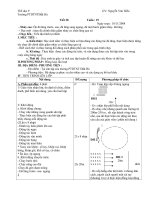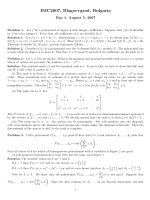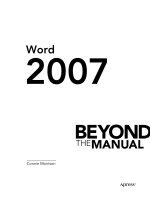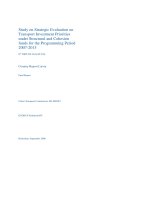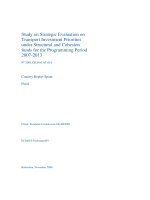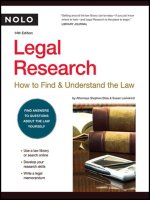The claisen rearrangement 2007 hiersemann nubbemeyer
Bạn đang xem bản rút gọn của tài liệu. Xem và tải ngay bản đầy đủ của tài liệu tại đây (9.9 MB, 594 trang )
The Claisen Rearrangement
Edited by
Martin Hiersemann and
Udo Nubbemeyer
1807–2007 Knowledge for Generations
Each generation has its unique needs and aspirations. When Charles Wiley first
opened his small printing shop in lower Manhattan in 1807, it was a generation
of boundless potential searching for an identity. And we were there, helping to
define a new American literary tradition. Over half a century later, in the midst
of the Second Industrial Revolution, it was a generation focused on building
the future. Once again, we were there, supplying the critical scientific, technical,
and engineering knowledge that helped frame the world. Throughout the 20th
Century, and into the new millennium, nations began to reach out beyond their
own borders and a new international community was born. Wiley was there, expanding its operations around the world to enable a global exchange of ideas,
opinions, and know-how.
For 200 years, Wiley has been an integral part of each generation s journey,
enabling the flow of information and understanding necessary to meet their
needs and fulfill their aspirations. Today, bold new technologies are changing
the way we live and learn. Wiley will be there, providing you the must-have
knowledge you need to imagine new worlds, new possibilities, and new opportunities.
Generations come and go, but you can always count on Wiley to provide you
the knowledge you need, when and where you need it!
William J. Pesce
President and Chief Executive Officer
Peter Booth Wiley
Chairman of the Board
The Claisen Rearrangement
Methods and Applications
Edited by
Martin Hiersemann and Udo Nubbemeyer
Editors:
Priv.-Doz. Dr. Martin Hiersemann
Institute of Organic Chemistry
University of Dortmund
Otto-Hahn-Strasse 6
44227 Dortmund
Germany
Prof. Dr. Udo Nubbemeyer
Institute of Organic Chemistry
University of Mainz
Duesbergweg 10–14
55099 Mainz
Germany
&
All books published by Wiley-VCH are carefully
produced. Nevertheless, authors, editors, and
publisher do not warrant the information contained in these books, including this book, to be
free of errors. Readers are advised to keep in mind
that statements, data, illustrations, procedural
details or other items may inadvertently be
inaccurate.
Library of Congress Card No.: applied for
British Library Cataloguing-in-Publication Data
A catalogue record for this book is available
from the British Library
Bibliographic information published by
The Deutsche Nationalbibliothek
The Deutsche Nationalbibliothek lists this
publication in the Deutsche Nationalbibliografie;
detailed bibliographic data is available in the
Internet at
© 2007 WILEY-VCH Verlag GmbH & Co. KGaA,
Weinheim
All rights reserved (including those of translation
into other languages). No part of this book may
be reproduced in any form – nor transmitted
or translated into machine language without
written permission from the publishers.
Registered names, trademarks, etc. used in this
book, even when not specifically marked as such,
are not to be considered unprotected by law.
Printed in the Federal Republic of Germany
Printed on acid-free paper
Typesetting Kühn & Weyh, Satz und Medien,
Freiburg
Printing betz-druck GmbH, Darmstadt
Bookbinding Litges & Dopf Buchbinderei GmbH,
Heppenheim
Wiley Bicentennial Logo Richard J. Pacifico
ISBN
978-3-527-30825-5
V
Contents
Preface
XV
List of Contributors
XVII
1
Chorismate-Mutase-Catalyzed Claisen Rearrangement 1
Hong Guo and Niny Rao
1.1
1.2
1.2.1
1.2.2
1.2.3
1.2.4
1.2.5
1.3
1.3.1
1.3.2
Introduction 1
Experimental Studies 2
Substrate Binding 2
Substrate Structural Requirements for Catalysis 3
X-ray Structures of Chorismate Mutase 4
Effects of Mutations 6
Activation Parameters 8
Catalytic Mechanism of Chorismate Mutase 9
Stabilization of Transition State by Active Site Residues 9
Substrate Conformational Transition and the Role of Active Site
Residues 10
Contribution of the Near Attack Conformers (NACs) 16
Strain Effects and Conformational Compression 19
Conclusion 20
References 21
1.3.3
1.3.4
1.4
2
Chiral-Metal-Complex-Catalyzed Aliphatic Claisen Rearrangement 25
Koichi Mikami and Katsuhiro Akiyama
2.1
2.2
2.3
2.4
2.5
Introduction 25
Binding Modes of Main-group and Late Transition Metals 26
Aluminum(III)-promoted Claisen Rearrangement 26
Copper(II)-catalyzed Claisen Rearrangement 32
Palladium(II)-catalyzed Claisen Rearrangement 38
References 42
VI
Contents
3
Aliphatic and Aromatic Claisen Rearrangement 45
3.1
Aliphatic Claisen Rearrangement 45
Hayato Ichikawa and Keiji Maruoka
3.1.1
3.1.2
3.1.2.1
3.1.2.2
3.1.2.3
3.1.2.4
3.1.2.5
3.1.2.6
3.1.2.7
3.1.2.8
3.1.2.9
3.1.2.10
3.1.2.11
3.1.3
3.1.3.1
3.1.3.2
3.1.3.3
3.1.3.4
3.1.3.5
3.1.3.6
3.1.3.7
3.1.4
3.1.4.1
3.1.4.2
3.1.5
3.1.6
3.1.7
3.1.7.1
3.1.7.2
3.1.7.3
3.1.7.4
3.1.7.5
3.1.7.6
3.1.8
3.1.8.1
3.1.8.2
3.1.8.3
3.1.9
Introduction 45
Synthesis of Allyl Vinyl Ethers 46
Hg-Catalyzed Synthesis 46
From Ammonium Betaine 46
Acid-Catalyzed Synthesis 46
Wittig Olefination 47
Sulfoxide Elimination 47
Selenoxide Elimination 49
From Ketal 49
From Allene 50
Ir-Catalyzed Synthesis 51
Cu-Catalyzed Synthesis 51
Tebbe Reagent 52
Acyclic Aliphatic Claisen Rearrangement 53
Transition State of Aliphatic Claisen Rearrangement 53
Secondary Allylic Ethers 54
Substituted Vinyl Ethers 56
Allyl Allenyl Ethers 57
Disubstituted Vinyl Ether 58
Water-Promoted Claisen Rearrangement 59
Diastereoselective Rearrangement Using Chiral Sulfoxide Groups 60
Claisen Rearrangement of Cyclic Allyl Vinyl Ethers 62
Ring Expansion Claisen Rearrangement 62
Cyclohexene Synthesis 68
Cyclic Vinyl Ethers 68
Cyclic Allyl Ethers 70
Tandem Reactions Including Aliphatic Claisen Rearrangement 71
Vinylation/Claisen Rearrangement 71
Allylation/Claisen Rearrangement 73
Anionic Cyclization/Claisen Rearrangement 74
Claisen Rearrangement/Ene Reaction 75
Claisen Rearrangement/Conia-Type Oxa-Ene Reaction 77
Oxy-Cope/Ene/Claisen Rearrangement 78
The Carbanion-Accelerated Claisen Rearrangement 78
Sulfonyl-Stabilized Anions 78
Phosphine Oxide and Phosphonate-Stabilized Anions 80
Phosphonamide-Stabilized Anions 82
Conclusion 83
References 83
Contents
3.2
Aromatic Claisen Rearrangement
Hisanaka Ito and Takeo Taguchi
86
3.2.1
3.2.2
3.2.2.1
3.2.2.2
3.2.2.3
3.2.3
3.2.3.1
3.2.3.2
3.2.3.3
3.2.4
3.2.4.1
3.2.4.2
3.2.4.3
3.2.4.4
3.2.4.5
3.2.4.6
3.2.4.7
3.2.5
3.2.6
3.2.6.1
3.2.6.2
3.2.7
3.2.7.1
3.2.7.2
3.2.7.3
3.2.7.4
Introduction 86
Mechanism 86
Ortho and Para Rearrangement 86
Transition State 87
Abnormal Claisen Rearrangement 88
Substrate and Substituent Effect 89
Preparation of Substrate 89
Aryl Unit 89
Allyl and Propargyl Unit 90
Reaction Conditions 92
Thermal Conditions 93
Solvent Effect 93
Brønsted Acid Catalyst 94
Lewis Acid Catalyst 94
Base Catalyst 96
Transition Metal Catalyst 97
Other Conditions 97
Thio-, Amino-, and Related Claisen Rearrangement 99
Asymmetric Synthesis 102
Intramolecular Chirality Transfer 102
Enantioselective Rearrangement 104
Synthetic Applications 104
Consecutive Cyclization 105
Tandem Reaction 106
Functional Molecule 109
Natural Products and Biologically Active Compounds 110
References 113
4
The Ireland–Claisen Rearrangement (1972–2004) 117
Christopher M. McFarland and Matthias C. McIntosh
4.1
4.2
4.3
4.4
4.4.1
4.4.2
4.4.3
4.4.3.1
4.4.3.2
4.4.3.3
4.5
4.5.1
Introduction 117
History 118
Numbering and Nomenclature 119
Rearrangement Temperature, Substituent Effects and Catalysis
Rearrangement Temperature 120
Substituent Effects 122
Catalysis 123
Pd(II) Catalysis 123
Lewis Acid Catalysis 123
Phosphine Catalysis 124
Transition State Structure 125
Isotope Effect Studies 125
120
VII
VIII
Contents
4.5.1.1 Deuterium Isotope Effects 125
14
4.5.1.2
C Isotope Effects 126
4.5.2
Theoretical Studies 126
4.5.2.1 Calculated vs. Experimental Isotope Effects and Transition State
Structure 126
4.5.2.2 Cyclohexenyl Allyl Methyl Ketene Acetals 127
4.6
Stereochemical Aspects 128
4.6.1
Simple Diastereoselection: Chair vs. Boat Transition States 128
4.6.1.1 Enolate and Silyl Ketene Acetal Geometry 128
4.6.1.2 Acyclic Allyl Silyl Ketene Acetals 129
4.6.2
Diastereoface Differentiation: Cyclic Allyl Silyl Ketene Acetals 129
4.6.3
Alkene Stereochemistry 131
4.6.4
Chirality Transfer 131
4.6.4.1 Allylic Esters Possessing One Stereocenter: Absolute Stereocontrol 131
4.6.4.2 Allylic Esters Possessing Multiple Stereocenters: Relative
Stereocontrol 132
4.6.5
Influence of Remote Stereocenters 135
4.6.5.1 C1′ Stereocenters 135
4.6.5.2 C5′ Stereocenters 140
4.6.5.3 C6′ Stereocenters 141
4.6.5.4 Other Remote Stereocenters 144
4.6.6
Chiral Auxiliary Mediated Asymmetric Ireland–Claisen
Rearrangements 145
4.6.6.1 Chiral Glycolates 145
4.6.6.2 Chiral Glycinates 146
4.6.6.3 Chiral Boron Ketene Acetals 147
4.7
Methods of Ketene Acetal Formation 147
4.7.1
Chemoselective Deprotonations 148
4.7.1.1 Ester vs. Ketone 148
4.7.1.2 Ester vs. Butenolide 149
4.7.1.3 Ester vs. Branched Ester 149
4.7.2
c-Deprotonations of Allyl Acrylates 149
4.7.3
Silyl Triflates and Tertiary Amine Bases 150
4.7.4
N,O-Bis(trimethylsilyl)acetamide and CuOTf 151
4.7.5
1,4-Additions 152
4.7.5.1 By Alkyl Cu Reagents 152
4.7.5.2 By Alkyl Radicals 153
4.7.5.3 By Enolates 153
4.7.5.4 By Silanes 154
4.7.6
Electrochemical Reduction 154
4.7.7
Diels–Alder Cycloaddition 155
4.7.8
Brook Rearrangement 155
4.7.9
Boron Ketene Acetals 156
4.7.10 Post-Rearrangement Enolization 157
4.8
Structural Variations in Allylic Esters 158
Contents
4.8.1
4.8.1.1
4.8.1.2
4.8.1.3
4.8.1.4
4.8.1.5
4.8.2
4.8.3
4.8.4
4.8.4.1
4.8.4.2
4.8.5
4.8.6
4.8.7
4.8.8
4.9
4.9.1
4.9.2
4.9.3
4.9.4
4.9.5
4.9.6
4.9.7
4.9.8
4.9.9
4.9.10
4.9.11
4.9.12
4.9.13
4.9.14
4.9.15
4.9.16
4.9.17
4.9.18
4.9.19
4.9.20
4.9.21
4.9.22
4.9.23
4.9.24
4.9.25
4.9.26
4.9.27
4.9.28
4.9.29
Allylic Esters with a-Heteroatoms 158
Glycolates 158
Lactates 162
Mandelates 163
Other Higher Esters 163
Glycinates and Other Higher Esters 164
Allyl Silanes and Stannanes 165
Glycals 167
Allyl Lactones 168
Lactones with Exocyclic Allylic Alkenes 169
Lactones with Endocyclic Allylic Alkenes 171
Tertiary Alcohol-Derived Allylic Esters 175
bis-Allylic Esters 178
Fe-Diene Complexes 179
Hindered Esters 179
Applications to Natural Product Synthesis 180
Prostanoids 180
Nonactic Acid 181
Lasalocid A 181
Tirandamycic Acid 182
Monensin A 183
Sphydofuran 185
Calcimycin 185
Ceroplasteric Acid 186
Erythronolide A 187
Ebelactone A and B 187
25-OH Vitamin D2 Grundmann Ketone 188
Zincophorin 188
Steroid Side Chain Homologation 189
Pseudomonic Acid C 189
Pine Sawfly Pheromone 190
Asteltoxin 191
Breynolide 191
Methyl Ydiginate 192
(–)-Petasinecine 192
b-Elemene 193
(+)-Dolabellatrienone 193
2-Keto-3-Deoxy-Octonic Acid (KDO) 194
Methylenolactocin 194
Eupomatilones 195
Trichothecenes 195
(±)-Widdrol 196
Equisetin 197
Muscone 197
Quadrone 198
IX
X
Contents
4.9.30
4.9.31
4.9.32
4.9.33
4.10
4.11
Ingenanes 198
(±)-Samin 200
(+)-Monomorine 200
Dictyols 201
Propargyl Esters 201
Conclusion 203
References 205
5
Simple and Chelate Enolate Claisen Rearrangement 211
5.1
Simple Enolate Claisen Rearrangement
Mukund G. Kulkarni
5.1.1
5.1.2
5.1.3
5.1.4
5.1.5
5.1.6
5.1.7
5.1.8
Introduction 211
History 212
Simple Enolates of Allylic Esters 214
Stereoselectivity in Enolate Formation 220
Simple Enolates of Allylic Esters of a-Hetero Acids 223
Simple Enolates of N-Allyl Amides 226
Miscellaneous Enolates 229
Conclusion 230
References 231
5.2
Chelate Enolate Claisen Rearrangement
Uli Kazmaier
5.2.1
5.2.2
Introduction 233
Claisen Rearrangements of Substrates with Chelating Substituents
in the a-Position 234
Rearrangement of a-Hydroxy Substituted Allylic Esters 234
Rearrangement of a-Alkoxy-Substituted Allylic Esters 239
a-Amido Substituents 256
Rearrangement of a-Thio Substituted Allylic Esters 288
Claisen Rearrangements of Substrates Bearing Chelating Substituents
in the b-Position 289
b-Hydroxy Substituents 289
b-Alkoxy Substitutents 291
b-Amino Substituted Substrates 291
Chelation Controlled Aza-Claisen Rearrangements 293
References 295
5.2.2.1
5.2.2.2
5.2.2.3
5.2.2.4
5.2.3
5.2.3.1
5.2.3.2
5.2.2.3
5.2.4
211
233
6
Claisen–Johnson Orthoester Rearrangement 301
Yves Langlois
6.1
6.2
6.3
Introduction 301
Historical Overview 301
Mechanistic Aspects 303
Contents
6.3.1
6.3.2
6.3.3
6.4
6.4.1
6.4.2
6.4.2.1
6.4.2.2
6.4.3
6.4.3.1
6.4.3.2
6.4.4
6.4.5
6.5
Reactivity 303
Stereoselectivity 306
Alternatives to the Orthoester Rearrangement 310
Synthetic Applications 312
Terpenes, Fatty Acids, and Polyketide Derivatives 312
Steroids 332
Syntheses of the Tetracyclic Core of Steroids 332
Syntheses of Steroid Side Chains 335
Alkaloids 340
Indole Alkaloids 340
Other Alkaloids 345
Carbohydrates 347
Miscellaneous Compounds 349
Conclusion 361
References 362
7
The Meerwein–Eschenmoser–Claisen Rearrangement 367
Stefan N. Gradl and Dirk Trauner
7.1
7.2
7.2.1
Definition, Discovery and Scope 367
Formation of Ketene N,O-Acetals 370
Condensation with Amide Acetals or Ketene Acetals
(Eschenmoser–Claisen Rearrangement) 370
7.2.2
Addition of Alkoxides to Amidinium Ions (Meerwein–Claisen
Rearrangement) 372
7.2.3
Addition of Alcohols to Ynamines and Ynamides (Ficini–Claisen
Rearrangement) 373
7.2.4
Miscellaneous Methods 374
7.3
Selectivity 376
7.3.1
Regioselectivity 376
7.3.2
Stereoselectivity 377
7.3.2.1 Cyclic Allylic Alcohols 377
7.3.2.2 Acyclic Allylic Alcohols 378
7.4
Applications in Synthesis 385
References 394
8
The Carroll Rearrangement 397
Mark A. Hatcher and Gary H. Posner
8.1
8.2
8.3
8.3.1
8.3.2
8.3.3
8.3.4
Introduction 397
Mechanism 398
Synthetic Applications 401
Tertiary and Quaternary Carbon Bond Formation 401
Natural Products 406
Steroidal Side-Chain Formation 412
Aromatic Carroll Rearrangements 415
XI
XII
Contents
8.4
8.4.1
8.4.2
8.4.3
8.5
Carroll Variants 419
a-Sulfonyl Carroll Rearrangement 419
Asymmetric Carroll Rearrangement 422
Metal-Catalyzed Carroll Rearrangement 426
Conclusion 429
References 429
9
Thio-Claisen Rearrangement 431
Stéphane Perrio, Vincent Reboul, Carole Alayrac, and Patrick Metzner
9.1
9.1.1
9.1.1.1
9.1.1.2
9.1.2
Introduction 431
Early Developments 431
Aromatic and Heteroaromatic Series 431
Aliphatic Series 433
Specificities of the Sulfur Version – Kinetics Versus
Thermodynamics 433
Reviews 435
Basic Versions 435
Flexible Synthesis of the Substrates 435
Scope and Limitations, Reaction Conditions 437
Synthesis of Unsaturated Aldehydes (via Transient Thioaldehydes) 437
Thioketones 437
Dithioesters 437
Thionesters 438
Thioamides 439
Thioketenes 439
Rearrangement of Tricoordinated Sulfur Derivatives:
Sulfonium Salts or Sulfoxides 440
Catalysis 441
Rearrangement with Stereochemical Control 441
Relative Control Exclusively Through Double-Bond Configurations 442
Control Through an Asymmetric Carbon Center 443
Stereogenic Sulfur Center 446
Cyclic Chiral Auxiliary 447
Axial Chirality 449
Applications in Organic Synthesis 449
Synthesis of Heterocycles 449
Synthesis of Natural Products and Construction of Building Blocks 451
Conclusion 455
References 455
9.1.3
9.2
9.2.1
9.2.2
9.2.2.1
9.2.2.2
9.2.2.3
9.2.2.4
9.2.2.5
9.2.2.6
9.2.2.7
9.2.3
9.3
9.3.1
9.3.2
9.3.3
9.3.4
9.3.5
9.4
9.4.1
9.4.2
9.5
Contents
10
Aza-Claisen Rearrangement 461
Udo Nubbemeyer
10.1
10.2
10.3
10.4
10.5
10.5.1
10.5.2
10.5.3
10.6
10.7
Introduction 461
Aromatic Simple Aza-Claisen Rearrangements 461
Aliphatic Simple Aza-Claisen Rearrangements 471
Amide Acetal and Amide Enolate Claisen Rearrangements 483
Zwitterionic Aza-Claisen Rearrangements 490
Alkyne Carbonester Aza-Claisen Rearrangements 491
Ketene Aza-Claisen Rearrangements 494
Allene Carbonester Aza-Claisen Rearrangements 511
Alkyne Aza-Claisen Rearrangements 512
Iminoketene Claisen Rearrangements 515
References 519
11
Mechanistic Aspects of the Aliphatic Claisen Rearrangement 525
Julia Rehbein and Martin Hiersemann
References 556
Subject Index
559
XIII
XV
Preface
Historically, the thermal rearrangement of aromatic and aliphatic allyl vinyl ether
was first published in 1912 by Ludwig Claisen. The neat carbon variant of this 3,3
sigmatropic bond reorganization, the Cope rearrangement, was reported in 1940,
38 years later. Thus, the Cope reaction should have been termed as a 3-carba-Claisen rearrangement. However, the reverse is found within the literature: the Claisen rearrangement is termed as a 3-oxa-Cope rearrangement. Consequentily, the
hetero Claisen reactions are found as 3-hetero-Cope conversions displaying heteroatoms such as nitrogen and sulfur in position 3 of the rearrangement framework. Carrying out a keyword supported literature search, this inconsistent use of
synonyms describing one and the same process should be strongly considered.
Within our book, we will use the historically exact name Claisen rearrangement.
Considering the widespread applications of the Claisen rearrangement, we should
keep in mind that Mother Nature has been utilizing the aliphatic version already
for a much longer period of time: the enzyme-catalyzed rearrangement of chorismate into prephenate also follows the same mechanism.
Although nowadays almost anybody seems to know something about the Claisen rearrangement, the exact nature of the transition state and the way substituents and solvents influence the rate and the selectivity of the reaction can be very
difficult to elucidate. However, for the vast majority of applications, qualitative
guidelines are sufficient to predict and/or explain the course of a Claisen rearrangement. One of the main conclusions from this book is that there isn’t the
Claisen rearrangement but a truly amazing number of mechanistically related
variations of it that have been and are being developed. In this context, the first
Claisen book presents a platform concerning basics and the state of the art.
From the breathtaking number of applications in target-oriented synthesis it
becomes evident that the Claisen rearrangement (and its variants) is one of the
most powerful stereoselective carbon-carbon-bond forming reactions. The efficiency of the reaction clearly profits from its atom economy. However, to be honest, access to the actual substrate for the rearrangement may prove costly. A particular strength is the predictability of the stereochemical course of the rearrangement based on the knowledge of the geometry of the cyclic transition state.
Still, even after more than 90 years of development, optimization and application of Claisen rearrangements, there is still plenty of room for further research.
XVI
Preface
With this in mind, we intended to provide interested researchers with a useful
guide to the scope and limitations of this versatile rearrangement. To realize this
task, we had to rely on various specialists who were originally contacted in the
beginning of 2003 and, indeed, many of them agreed to contribute to the Claisen
book. We are deeply indebted to all the authors who spent their limited time
resources to compile a truly outstanding collection of facts concerning the various
Claisen rearrangements. This book will certainly serve as a reference for many
years to come.
Dortmund and Mainz
Martin Hiersemann and Udo Nubbemeyer
XVII
List of Contributors
Katsuhiro Akiyama
Department of Applied Chemistry
Tokyo Institute of Technology
2-12-1S1-29 Ookayama, Meguro-ku
Tokyo 152-8552
Japan
Mark A. Hatcher
Department of Chemistry
The Johns Hopkins University
3400 North Charles Street
Baltimore, MD 21218
USA
Carole Alayrac
Organisch-Chemisches Institut der
Westfälischen Wilhelms-Universität
Münster
Corrensstrasse 40
48149 Münster
Germany
Martin Hiersemann
Institute of Organic Chemistry
University of Dortmund
Otto-Hahn-Strasse 6
44227 Dortmund
Germany
Stefan N. Gradl
Department of Chemistry
University of California at Berkeley
628 Latimer Hall
Berkeley, CA 94720
USA
Hong Guo
Department of Biochemistry,
Cellular and Molecular Biology
University of Tennessee
M407 Walters Life Sciences Building
Knoxville, TN 37996-0840
USA
Hayato Ichikawa
Osaka University of Pharmaceutical
Sciences
4-20-1 Nasahara
Takatsuki, Osaka, 569-1094
Japan
Hisanaka Ito
Department of Pharmacy and
Life Science
Tokyo University
1432-1 Horinouchi, Hachioji
Tokyo 192-0392
Japan
XVIII
List of Contributors
Uli Kazmaier
Institute of Organic Chemistry
University of the Saarland
Building C 4.2
P.O. Box 15 11 50
66041 Saarbrücken
Germany
Patrick Metzner
Laboratoire de Chimie Moléculaire et
Thioorganique (UMR CNRS 6507)
ENSICAEN-Université de Caen
6 Boulevard du Maréchal Juin
14050 Caen
France
Mukund G. Kulkarni
Department of Chemistry
University of Pune
Pune 411 007
India
Koichi Mikami
Department of Applied Chemistry
Tokyo Institute of Technology
2-12-1S1-29 Ookayama, Meguro-ku
Tokyo 152-8552
Japan
Yves Langlois
Laboratoire de Synthèse des
Substances Naturelles
Université de Paris-Sud
Bâtiment 410
91405 Orsay
France
Keiji Maruoka
Department of Chemistry
Kyoto University
Sakyo, Kyoto 606-8502
Japan
Christopher M. McFarland
Department of Chemistry and
Biochemistry
University of Arkansas
Fayetteville, AR 72701
USA
Matthias C. McIntosh
Department of Chemistry and
Biochemistry
University of Arkansas
Fayetteville, AR 72701
USA
Udo Nubbemeyer
Institute of Organic Chemistry
University of Mainz
Duesbergweg 10–14
55128 Mainz
Germany
Stéphane Perrio
Laboratoire de Chimie Moléculaire et
Thioorganique (UMR CNRS 6507)
ENSICAEN-Université de Caen
6 Boulevard du Maréchal Juin
14050 Caen
France
Gary H. Posner
Department of Chemistry
The Johns Hopkins University
3400 North Charles Street
Baltimore, MD 21218
USA
List of Contributors
Niny Rao
Department of Biochemistry,
Cellular and Molecular Biology
University of Tennessee
M407 Walters Life Sciences Building
Knoxville, TN 37996-0840
USA
Takeo Taguchi
Department of Pharmacy and
Life Science
Tokyo University
1432-1 Horinouchi, Hachioji
Tokyo 192-0392
Japan
Vincent Reboul
Laboratoire de Chimie Moléculaire et
Thioorganique (UMR CNRS 6507)
ENSICAEN-Université de Caen
6 Boulevard du Maréchal Juin
14050 Caen
France
Dirk Trauner
Department of Chemistry
University of California at Berkeley
602 Latimer Hall
Berkeley, CA 94720
USA
Julia Rehbein
Institute of Organic Chemistry
University of Dortmund
Otto-Hahn-Strasse 6
44227 Dortmund
Germany
XIX
1
1
Chorismate-Mutase-Catalyzed Claisen Rearrangement
Hong Guo and Niny Rao
1.1
Introduction
Chorismic acid is the key branch point intermediate in the biosynthesis of aromatic amino acids in microorganisms and plants (Scheme 1.1a) [1]. In the branch
that leads to the production of tyrosine and phenylalanine, chorismate mutase
(CM, chorismate-pyruvate mutase, EC 5.4.99.5) is a key enzyme that catalyzes the
isomerization of chorismate to prephenate (Scheme 1.1b) with a rate enhance6
7
ment of about 10 –10 -fold. This reaction is one of few pericyclic processes in biology and provides a rare opportunity for understanding how Nature promotes such
unusual transformations. The biological importance of the conversion from chorismate to prephenate and the synthetic value of the Claisen rearrangement have
led to extensive experimental investigations [2–43].
In addition, the reaction catalyzed by chorismate mutase is a paradigm for the
study of enzyme mechanism and has been a subject of extensive computational
investigations [44, 47–83]. One of the main reasons for the current focus on the
mechanism of this enzyme is the fact that the reaction is a straightforward unimolecular rearrangement of the substrate with no chemical transformations in the
enzyme or the solvent during the reaction. This eliminates many of the problems
that arise for other cases and may help to settle some of the long-standing issues
concerning the origin of the catalysis [84].
Experimental results for the CM-catalyzed and uncatalyzed reaction, as well as
structural information for chorismate mutase, have been extensively discussed in
two previous reviews [2, 3]. There has been a rapid growth of literature in computational studies of chorismate mutase in the last few years. In this chapter, we
shall begin by summarizing some key experimental data related to the Claisen rearrangement along with existing structural information for chorismate mutase.
We will then review the results of computational studies of chorismate mutase
and discuss different proposals that have been suggested for the mechanism of
the CM-catalyzed reaction.
2
1 Chorismate-Mutase-Catalyzed Claisen Rearrangement
a)
CO2
chorismate
mutase
O
NH2
NH2
CO2
O
O2C
CO2H
CO2H
CO2
OH
OH
chorismate
OH
tyrosine
prephenate
anthranilate
synthase
phenylalanine
HO2C
CO2H
NH2
H2N
N
tryptophan
anthranilate
b)
11
O2C
CO2
1
4
OH
O2C
CO2
O
9
6
O
CO2
3
O
7
8
CO2
10
12
OH
OH
Scheme 1.1
1.2
Experimental Studies
1.2.1
Substrate Binding
Knowles and coworkers [13, 14] demonstrated that the rearrangement of chorismate to prephenate proceeds through the same transition state (1, TS in Scheme 1.2)
in solution and at the enzyme active site. The atoms of the [3,3]-pericyclic region
in this TS are arranged in a “chair-like” configuration. The result of Knowles and
coworkers has led to the suggestion that the bond breaking and making process
starts from a chair-like pseudodiaxial conformer of chorismate (2, CHAIR in
Scheme 1.2), where C1 and C9 are positioned to form the carbon-carbon bond, as
required for the Claisen rearrangement. Thus, one straightforward way for chorismate mutase to catalyze the rearrangement is to bind the CHAIR conformer preferentially from solution and then catalyze its chemical transformation at the active
site. A requirement for such a mechanism is a sufficiently large population of the
CHAIR conformer in solution. To determine the population of CHAIR in solu1
tion, Copley and Knowles [15] measured the temperature variation of the H coupling constants for the protons in the ring of chorismate. It was shown that al-
1.2 Experimental Studies
3
though the dominant conformer(s) is a pseudodiequatorial conformation (see 3 of
Scheme 1.2 for a schematic diagram), a pseudodiaxial conformer(s) exists at a reasonable level (∼12%) in solution. Copley and Knowles [15] assumed that the pseudodiaxial conformer they observed in the NMR experiment was the CHAIR conformer and concluded that the enzyme could bind this reactive conformer directly
from solution and catalyze its chemical transformation at the active site. But a later study of the transferred nuclear Overhauser effects for chorismate by Hilvert
and his coworkers [17] failed to find evidence for the existence of CHAIR in solution. Recent molecular dynamics (MD) simulations [82, 83] suggested that the
NMR data could correspond to other pseudodiaxial conformer(s) rather than
CHAIR (see below).
H
O2C
O2C
O
9
O
CO2
1
H
CO2
HO
H
OH
H
OH
TS(1)
O2C
O CO
2
CO2
CHAIR(2)
O
H
OH
CO2
DIEQ(3)
TSA(4)
Scheme 1.2
1.2.2
Substrate Structural Requirements for Catalysis
The structural features of the substrate required for binding and catalysis by
Escherichia coli chorimate mutase (P-protein EcCM) and Bacillus subtillus chorismate mutase (BsCM) have been studied [22, 23]. Besides the allyl vinyl ether, the
two carboxylic acid groups in chorismic acid were found to be very important for
the catalysis. For instance, experimental studies [22] showed that ester 5 (see
Scheme 1.3) was not a substrate or inhibitor for EcCM, suggesting that the presence of the sidechain carboxyl group is crucial for the binding and catalysis.
EcCM and BsCM were also unable to catalyze the rearrangement of 6 (which lacks
the ring carboxylic acid group) [22, 23], even though 6 proved to be a weak to modest competitive inhibitor (Ki of 6 is 0.4 mM and 0.5 mM for EcCM and BsCM,
repectively; for chorismate Km is 0.32 mM and 0.28 mM, respectively). Thus, the
existence of the ring carboxyl group is also essential for the catalysis, but may not
R1
5: R1 = CO2H; R2 = CO2Me; R3 = OH
6: R1 = H; R2 = CO2H; R3 = OH
O
R
Scheme 1.3
3
C
R2
7: R1 = CO2H; R2 = CO2H; R3 = OMe
4
1 Chorismate-Mutase-Catalyzed Claisen Rearrangement
be required for the binding. Analog 7 was a reasonable substrate for EcCM
–1
4
(Km = 1.9 mM and kcat = 0.56 s ) with a rate acceleration (kcat/kuncat) of 2 × 10 by the
6
enzyme; for chorismic acid kcat/kuncat = 2 × 10 . Thus, the free hydroxyl group at C4
may not be required for the catalysis by EcCM, but it is not clear whether this is
also the case for BsCM (see below).
1.2.3
X-ray Structures of Chorismate Mutase
A number of X-ray structures for chorismate mutase are available. The structures
of BsCM and Saccharomyces cerevisiae (yeast) CM complexed with an endo-oxabicyclic transition state analog inhibitor (4, TSA in Scheme 1.2) [19] have been determined by Lipscomb and coworkers [6, 7, 12, 34]; the structures without TSA
bound were also obtained for BsCM and yeast CM as well as for some of their
mutants [8, 10, 12, 31]. The X-ray structures for the monofunctional amino-terminal chorismate mutase domain engineered from the P-protein (EcCM) and a less
active catalytic antibody 1F7 complexed with TSA have been determined by Lee
et al. [4] and Haynes et al. [33], respectively. Both EcCM and yeast CM are homodimers, whereas BsCM is a homotrimer. It has been demonstrated that the dimer
of EcCM can be superimposed onto a monomer of yeast CM [4, 11, 34], indicating a
common evolutionary origin of the two CMs with an ancestral protein that was structurally closer to EcCM than to yeast CM [34]. Moreover, there was a possible gene
duplication event in the evolution of yeast CM [34], allowing the formation of the regulatory domain for this enzyme. The structure of BsCM, which consists mainly of
b-sheets, is different from the almost all-helical structures of EcCM and yeast CM.
Scheme 1.4 shows the schematic diagrams for the active site structures of EcCM
[4], yeast CM [12, 34], BsCM [6, 7] and catalytic antibody 1F7 [33]. The active site of
BsCM is somewhat open and more solvent accessible than the more buried catalytic packets in EcCM and yeast CM. As is evident from Scheme 1.4a and b, most
of the active site residues in EcCM and yeast CM are conserved. For instance, in
the both cases the guanidinium groups of two Arg residues (Arg28 and Arg11′ in
EcCM and Arg16 and Arg157 in yeast CM, respectively) form salt bridges with the
carboxylate groups of the inhibitor. Lys39 (Lys168) in EcCM (yeast CM) is in
hydrogen bond distances to the sidechain carboxylate group and the ether oxygen
of TSA. A major difference between the two active sites is that the other residue
interacting with the ether oxygen is Gln in EcCM (Gln88), but is Glu in yeast CM
(Glu246). It has been shown that Glu246 has to be protonated for functionality of
yeast CM. The replacement of Glu246 by Gln changes the pH optimum for the
activity from a narrow to a broad pH range, even though the kinetic parameters
are not significantly affected by the mutation (e.g., the effect on kcat/Km is less
than 10-fold) [28]. Consistent with these observations on yeast CM, the replacement of Gln88 in EcCM by Glu leads to loss of activity of 700-fold at pH 7.5, but
3
the activity of the Gln88Glu mutant can be reduced almost 10 -fold by simply lowering the pH to 4.9 [27] (see Table 1.1 and the next section for more details on the
effects of mutations).

